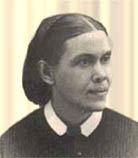Understanding Seventh-Day Adventism
 Seventh-
Seventh-
Other adventists believed that the Second Coming had been hindered by their failure to maintain the O.T. law of keeping the seventh day as the Sabbath. The emphasis on Sabbath-keeping was also established by visions, especially those of Ellen G. White (d.1915), whose importance to the movement cannot be overstressed. In her account of one of her early visions, she writes of being carried in the Spirit into the Holy City and being shown by Jesus the stone tables of the law – "On one table were written four, and on the other six. The four on the first table shone brighter than the other six. But the fourth, the Sabbath commandment, shone above them all; for the Sabbath was set apart to be kept in honour of God’s holy name. The holy Sabbath looked glorious – a halo of glory was all around it" ( Early Writings, pp.32-33).
There have been significant changes in doctrinal emphasis across the years, so that the Adventism of today consciously seeks to be accepted as a Christian denomination rather than a sect group. Walter Martin writes, "It is my conviction that one cannot be a true Jehovah’s Witness, Mormon, Christian Scientist, Unitarian, Spiritist, etc., and be a Christian in the Biblical sense of the term; but it is perfectly possible to be a Seventh-Day Adventist and be a true follower of Jesus Christ despite certain heterodox concepts..." ( The Kingdom of the Cults, 1984, p.409). Martin acknowledges that not all would agree with this viewpoint.
The major problem is their view that the Kingdom and purposes of God focus on their church and ministry alone. When the Adventist message has been proclaimed throughout the world and their church has grown to its predetermined size, then the end of the age will come. At that time, so they teach, the righteous dead will be raised and together with the righteous living will be taken to heaven, where they will spend the Millennium. While believers enjoy heavenly bliss, Satan will be left on earth for 1000 years. At the end of this time, Christ will descend with his saints, destroy the wicked with fire, and create a new earth with the New Jerusalem as its centre.
Adventists insist on the proper care of the body, abstaining from foods forbidden in the Old Testament, such as pork, ham and shellfish; do not smoke or drink; and are involved in programmes to help those who wish to give up those habits. The church also opposes secret societies, card playing, gambling, the use of jewellery and cosmetics and "worldly entertainments."
© Peter J Blackburn, 1991,1999. This material was originally prepared for Antioch School. Permission is given for the printing and use of this material by congregations and individuals.
